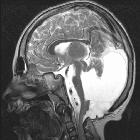classification system for midline abnormalities of the brain
Classification systems for midline abnormalities of the brain and skull are varied and constantly changing as the underlying embryology and genetics are uncovered. A relatively simple and robust classification system is based on the location of abnormalities, always remembering that midline abnormalities often 'travel in packs'.
- cephaloceles
- by location: cranial vault or skull base
- by content: meninges only or also contain brain tissue
- nasal region
- nasal dermoid
- nasal glioma
- nasal dermal sinus
- cerebral hemispheres
- holoprosencephaly/septo-optic dysplasia spectrum
- septo-optic dysplasia
- lobar holoprosencephaly
- semilobar holoprosencephaly
- alobar holoprosencephaly
- middle interhemispheric variant/syntelencephaly
- holoprosencephaly/septo-optic dysplasia spectrum
- corpus callosum
- intracranial lipoma
- cerebellum (for more details see classification system for malformations of the cerebellum)
Siehe auch:
- intrakranielle Lipome
- Corpus callosum
- Holoprosencephalie
- Septo-optische Dysplasie
- semilobar holoprosencephaly
- Rhombencephalosynapsis
- Joubert-Syndrom
- Dysgenesie des Corpus callosum
- alobäre Holoprosencephalie
- Dandy Walker continuum
- classification system for malformations of the cerebellum
- lobäre Holoprosencephalie
- Zephalozele
- Syntelenzephalie
- nasal glioma
und weiter:

 Assoziationen und Differentialdiagnosen zu classification system for midline abnormalities of the brain:
Assoziationen und Differentialdiagnosen zu classification system for midline abnormalities of the brain:













